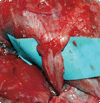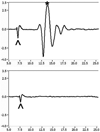A model for functional recovery and cortical reintegration after hemifacial composite tissue allotransplantation
- PMID: 19182661
- PMCID: PMC3050507
- DOI: 10.1097/PRS.0b013e318191bca2
A model for functional recovery and cortical reintegration after hemifacial composite tissue allotransplantation
Abstract
Background: The ability to achieve optimal functional recovery is important in both face and hand transplantation. The purpose of this study was to develop a functional rat hemifacial transplant model optimal for studying both functional outcome and cortical reintegration in composite tissue allotransplantation.
Methods: Five syngeneic transplants with motor and sensory nerve appositions (group 1) and five syngeneic transplants without nerve appositions (group 2) were performed. Five allogeneic transplants were performed with motor and sensory nerve appositions (group 3). Lewis (RT1) rats were used for syngeneic transplants and Brown-Norway (RT1) donors and Lewis (RT1) recipients were used for allogeneic transplants. Allografts received cyclosporine A monotherapy. Functional recovery was assessed by recordings of nerve conduction velocity and cortical neural activity evoked by facial nerve and sensory (tactile) stimuli, respectively.
Results: All animals in groups 1 and 3 showed evidence of motor function return on nerve conduction testing, whereas animals in group 2, which did not have nerve appositions, did not show electrical activity on electromyographic analysis (p < 0.001). All animals in groups 1 and 3 showed evidence of reafferentation on recording from the somatosensory cortex after whisker stimulation. Animals in group 2 did not show a cortical response on stimulation of the whiskers (p < 0.001).
Conclusion: The authors have established a hemiface transplant model in the rat that has several modalities for the comprehensive study of motor and sensory recovery and cortical reintegration after composite tissue allotransplantation.
Conflict of interest statement
Figures








Similar articles
-
Functional outcome after facial allograft transplantation in rats.J Plast Reconstr Aesthet Surg. 2008 Sep;61(9):1034-43. doi: 10.1016/j.bjps.2007.12.084. Epub 2008 Jul 14. J Plast Reconstr Aesthet Surg. 2008. PMID: 18621596
-
Cortical reintegration after facial allotransplantation.J Neurophysiol. 2023 Feb 1;129(2):421-430. doi: 10.1152/jn.00349.2022. Epub 2022 Dec 21. J Neurophysiol. 2023. PMID: 36542405
-
Sensorimotor recovery after partial facial (mystacial pad) transplantation in rats.Ann Plast Surg. 2009 Oct;63(4):428-35. doi: 10.1097/SAP.0b013e31819031ef. Ann Plast Surg. 2009. PMID: 19745713
-
Pathways of sensory recovery after face transplantation.Plast Reconstr Surg. 2011 May;127(5):1875-1889. doi: 10.1097/PRS.0b013e31820e90c3. Plast Reconstr Surg. 2011. PMID: 21532417 Review.
-
Putative roles of soluble trophic factors in facial nerve regeneration, target reinnervation, and recovery of vibrissal whisking.Exp Neurol. 2018 Feb;300:100-110. doi: 10.1016/j.expneurol.2017.10.029. Epub 2017 Nov 8. Exp Neurol. 2018. PMID: 29104116 Review.
Cited by
-
Whole-eye transplantation: a look into the past and vision for the future.Eye (Lond). 2017 Feb;31(2):179-184. doi: 10.1038/eye.2016.272. Epub 2016 Dec 16. Eye (Lond). 2017. PMID: 27983731 Free PMC article.
-
Early recovery of neuronal functioning in the sensory cortex after nerve reconstruction surgery.Restor Neurol Neurosci. 2019;37(4):409-419. doi: 10.3233/RNN-190914. Restor Neurol Neurosci. 2019. PMID: 31322584 Free PMC article.
-
Preservation of Murine Whole Eyes With Supplemented UW Cold Storage Solution: Anatomical Considerations.Transl Vis Sci Technol. 2024 Nov 4;13(11):24. doi: 10.1167/tvst.13.11.24. Transl Vis Sci Technol. 2024. PMID: 39560629 Free PMC article.
-
Cutaneous collateral axonal sprouting re-innervates the skin component and restores sensation of denervated Swine osteomyocutaneous alloflaps.PLoS One. 2013 Oct 18;8(10):e77646. doi: 10.1371/journal.pone.0077646. eCollection 2013. PLoS One. 2013. PMID: 24204901 Free PMC article.
-
Multivisceral transplantation of pelvic organs in rats.Front Surg. 2023 Apr 20;10:1086651. doi: 10.3389/fsurg.2023.1086651. eCollection 2023. Front Surg. 2023. PMID: 37151860 Free PMC article.
References
-
- Gander B, Brown CS, Vasilic D, et al. Composite tissue allotransplantation of the hand and face: A new frontier in transplant and reconstructive surgery. Transpl Int. 2006;19:868–880. - PubMed
-
- Gordon CR, Nazzal J, Lozano-Calderan SA, et al. From experimental rat hindlimb to clinical face composite tissue allotransplantation: Historical background and current status. Microsurgery. 2006;26:566–572. - PubMed
-
- Devauchelle B, Badet L, Lengele B, et al. First human face allograft: Early report. Lancet. 2006;368:203–209. - PubMed
-
- Giraux P, Sirigu A, Schneider F, Dubernard JM. Cortical reorganization in motor cortex after graft of both hands. Nat Neurosci. 2001;4:691–692. - PubMed
Publication types
MeSH terms
Grants and funding
LinkOut - more resources
Full Text Sources

